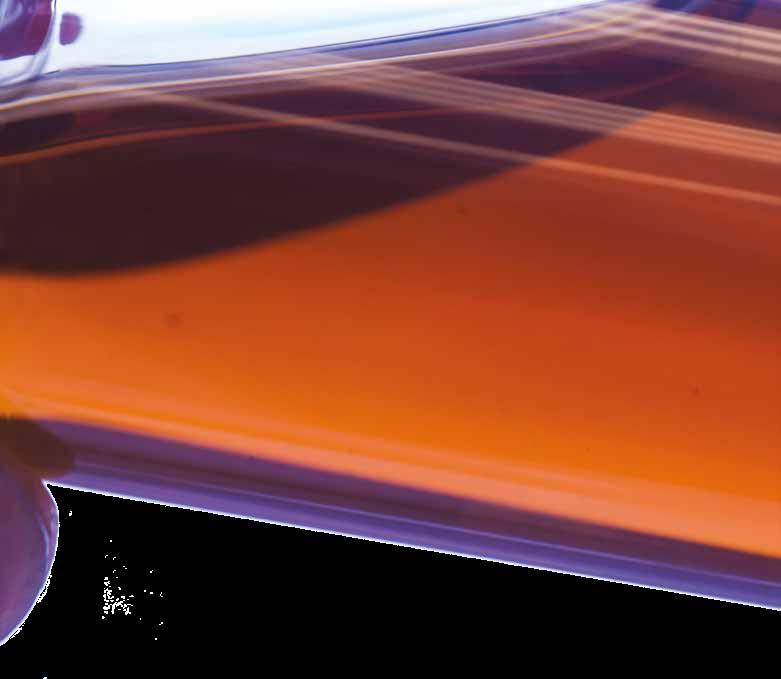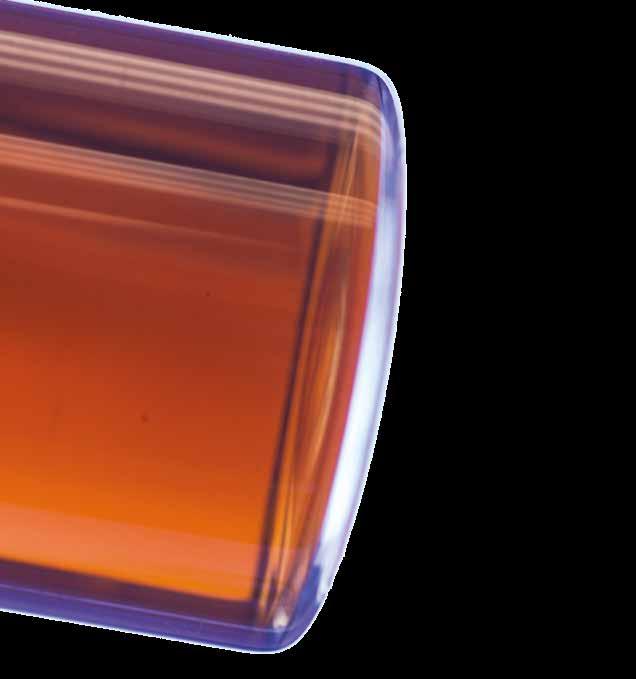
9 minute read
innovation
Taking nanotechnology from lab to market: a graphene oxide case study
The team at William Blythe Ltd explains how graphene oxide production has been scaled up to meet increased global demand for the novel material.
Advertisement
WHAT IS GRAPHENE OXIDE?
Graphene oxide (GO) is a derivate of graphene, the 2-dimensional material discovered at the University of Manchester by Nobel Prize winning scientists Andre Geim and Kostya Novoselov. Like graphene, GO is made up of a single layer of carbon atoms arranged in a 2D hexagonal lattice. This structure gives the material remarkable strength, thermal conductivity and sensing properties. In contrast to graphene, GO has oxygenated functional groups distributed across the ‘sheet’, which disrupt the delocalised electron structure and lead to greatly reduced electronic properties. These oxygen-containing groups do however enable greater functionality in dispersing the single layers across a range of systems, and can be functionalised to tune the hydrophilic properties.
MANUFACTURING GRAPHENE OXIDE
The two most common manufacturing routes for GO are by electrochemical oxidation of solid graphite (e.g. graphite rods) and wet chemical oxidation of graphite powder. For scalability and reproducibility of consistent material, the latter process is desirable, and was the method chosen by the William Blythe chemists when the R&D work began in 2015. Coincidently, the first reported synthesis of GO or “graphic acid”, as it was stated in this paper, was published in 1859 by Benjamin Brodie [1], 14 years after William Blythe Limited was incorporated. Brodie’s method employed potassium chlorate and fuming nitric acid as the strong oxidiser & acid combination required to intercalate between the graphite layers and react with the delocalised electron structure.
Over the years this method has been optimised in academia to improve its safety, resulting in the most common method now employed commercially, the Hummers method. This method utilised sodium nitrate and potassium permanganate in concentrated sulfuric acid to produce a GO material with a high oxygen content, an important property that correlates strongly with a high yield of single-layered GO.
APPLICATION & COMMERCIALISATION
For those informed in the graphene space, you’ll know it has been researched across hundreds of different applications. Given the hype, William Blythe has been careful in selecting key application areas for internal developments of its material. Whilst the William Blythe GO has been used in gas sensing [2], CO2 capture [3] and biomedical [4] applications in academia, the company has also explored it’s use in water purification and energy storage in commercial UKRI projects. The current drivers for the scale-up to a 50-tonne/year capacity are in filtration and polymer additive applications, and the company continues to work with partners in other areas to help commercialise this nanomaterial.

TRANSFER FROM LAB TO PLANT
As commercial demand for William Blythe GO increased in 2020, the decision was made to transfer the optimised lab method to the next stage in scale-up. Early in the process, the operations team highlighted a few key challenges: 1. Temperature Control = heating is required for maximum oxidation, however too high temperatures can lead to safety concerns. This therefore requires significant temperature control and the relevant safety interlocks.
2. Addition Rate & Sequence = like many chemical processes, the addition rate is key in controlling product properties and any exotherms arising from the addition of acids and oxidising agents. 3. Oxidiser Quenching = strong oxidising agents require quenching post reaction to ensure safe waste streams at the end of the process. Controlling this process to ensure limited temperature variation is critical for safe operation. 4. Purification = nanomaterials can be difficult to purify through conventional methods as a result of their tiny size and in the case of GO, 2D sheet-like morphology. To combat these, a combination of R&D and Operations worked through the relevant hazard studies to ensure that the safest process was being pursued, worst-case scenarios analysed & mitigations implemented, and all occupational hazards taken into account during the plant design phase. This was all supported by the top tier COMAH site status and decade’s worth of experience the company has in safely handling hazardous chemistries. Another key enabler to scaling up the Hummers method is William Blythe’s on-site wastewater treatment plant, which is well equipped to handle the large quantities of acids and the oxidising agent by-products, ensuring a safe effluent stream. The team is now working on routes to recycle the sulfate waste in existing processes, in pursuit of more circularity within the manufacturing site. All of the above led to the development of a safe production route, but the last remaining challenge was to ensure the high purity remained from lab to plant. Utilising internal know-how and significant R&D efforts, a scalable purification method was developed to produce a highquality material with very low batch to batch variability.
REFERENCES
1. Royal Society, 1859, 149, pp.249-259 2. Carbon Trends, 2021, 5 (100123), pp.1-7 3. Advanced Functional Materials, 2020, 30 (40) 4. Dental Materials, 2019, 35(11), pp.1614-1629
William Blythe is a speciality chemicals manufacturer based in Accrington, UK. The company is one of the leading manufacturers of graphene oxide globally, and a world leader in the development of inorganic chemicals since its formation in 1854. From its origins of creating dyestuffs for the textile industry in the North West, it has evolved to become a leading manufacturer of tin, copper and iodine derivatives supplied into applications such as gas purification absorbents, flame-retardant synergists for plastics and iodinecontaining food additives. Since 2012 the company has invested significantly in developing advanced materials such as graphene oxide and doped-metal oxides, expanding the product portfolio into new chemistries and applications.
williamblythe.com

Metal-eating plant method wins acclaim for ‘eco catalyst’ farmer
French scientist Claude Grison has won a top European Inventor Award for her ‘green’ method of decontaminating polluted soils with metal-eating plants.
The award from the European Patent Office recognises the work of the University professor and research director at the French National Centre for Scientific Research (CNRS) to extract metal elements from the soil and use them as “ecocatalysts” to make new molecules. Grison’s method helps decontaminate soil and provides a new source of catalysts, which could be used to produce biodegradable plastics, antimitotics (used in cancer treatment), capped DNA and RNA, cosmetics and key intermediates for fine chemistry.
FROM BOTANY TO CHEMISTRY
Grison’s invention was inspired by a question from her students as to whether metal-accumulating plants could be used to remediate old mining sites. She realised that if she could find a way to harvest the metal contained in the plants, it would open up a new source of materials such as zinc and nickel, which are used to make catalysts for the chemical industry. Few in the scientific community believed it was possible, but Grison was undeterred. In 2011, she applied for a European patent for her method for extracting metals to produce catalysts, enabling her to commercialise her work. Grison and her team now use these ‘eco catalysts’ to produce new types of molecules for the chemical, pharmaceutical and cosmetics industries. So far, the team has synthesised 5000 such biomolecules, which they are starting to commercialise, as well as a mosquito repellent with ingredients made by eco catalysis. Grison said that despite being a research scientist, she is motivated by the potential impact of her work. “I do not want to be a mere researcher; I want to be a citizen researcher. I want my research to be useful, so that it can be transferred towards society, that it ends up contributing, even if just a little, to solving a big problem,” she explained. Grison was honoured in the Research category of the European Inventor Awards, a hybrid event watched online by a worldwide audience. The Award is one of Europe’s most prestigious innovation prizes and is presented annually to outstanding inventors from Europe and beyond who have made an exceptional contribution to society, technological progress and economic growth. “Our Award recognises inventors that have demonstrated a new way of thinking. By marrying botany and chemistry, Claude Grison has found an original way to solve two problems simultaneously. First, her solution could help the chemical industry reduce its environmental impact. Then, she has tapped into a new source of raw materials highly valued by several industries,” explained António Campinos, President of the European Patent Office. Claude graduated with a PhD in Molecular Chemistry from the University of Lorraine, France in 1987. Between 1994 and 2003 she was a Professor of Chemistry at the University of Nancy and from 2008 to 2013 at the University of Montpellier before accepting her current position at the CNRS (also at Montpellier) in 2016. She is named inventor of European patent EP2504096B1 (granted 2019), co-owned by the CNRS and the University of Montpellier.
World’s first renewable surfactant paves way for circular chemistry
Cepsa Química has supplied consumer goods manufacturer Unilever with NextLab linear alkylbenzene (LAB), a new range of sustainable products which include renewable and recycled raw materials.
This sets a new milestone for circular chemistry, as NextLab linear alkybenzene (LAB) is made using ‘green carbon’ derived from biomass instead of the fossil fuels the industry has employed until now to make cleaning and laundry products. Cepsa Química uses a Mass Balance approach to create NextLab. Through Mass Balance, traditional black carbon sources are blended and co-processed with those from plant-based sources, known as green carbon. Afterwards, they are tracked throughout the entire production process to ensure that an appropriate volume of the green carbon content is in the final LAS surfactant.

The company claims this way of manufacturing surfactants is not only the most viable, short-term alternative to purely fossil-carbon derived products, but also constitutes a big stepping stone in the shift from petrochemical to renewable feedstocks. Unilever is the worlds’ first user of NextLab linear alkylbenzene (LAB), which incorporates biomass of certified origin, resulting in an LAB surfactant identical in properties and performance to traditional surfactants. The company will use NextLab to make Linear Alkylbenzene Sulfonate (LAS), the world’s largest-volume synthetic surfactant and its key raw material for brands such as Persil, Cif and Sunlight. Surfactants are crucial in the making of cleaning products. However, all LAS surfactant is made nowadays from black carbon and fossil fuels. Using a LAB made from renewable biomass to produce LAS is not only a more sustainable way to produce this raw material but also aims to help lower the carbon footprint of the final products.
ROUTE TO A CIRCULAR CHEMISTRY
As of today, 85% of the overall carbon demand in chemical and derived materials sector is still met using fossil fuels. According to Cepsa Química, by offering renewable and recycled alternatives, it has set a new route to a circular chemistry industry, both in its own production process and in that of its buyers. Unilever’s Home Care business announced last year that it will source 100% of the carbon derived from black sources in its cleaning and laundry formulations with renewable or recycled carbon – a strategy illustrated in its Carbon Rainbow model.
With the chemicals used in Unilever’s cleaning and laundry products making up the greatest proportion of their carbon footprint (46%) across their lifecycle, these new chemicals made with renewable feedstocks will help the company reduce its carbon footprint. A spokesperson added that including NextLab within formulations will result in no change to product performance.









